The aim of the study is to develop an efficient, innovative method of perforating oil and gas well casing strings with a high-velocity stream of polymer solution that conserves resources and energy and meets the requirements for environ- mentally friendly hydrocarbon production. New knowledge about the dynamics of polymer solutions in the model conditions of flow through the nozzles of the hydro perforator, which form a high-velocity jet, became the main scientific basis for substantiating the water-polymer method of hydro perforation of oil and gas wells. The study of the reaction of polymer solutions to tension hydrodynamic influence allowed to formulate a structural concept, the "common denominator" of which is the strong deformation effect of tension hydrodynamic field on high molecular weight coils, which, according to nonequilibrium thermodynamics, should cause a kind of high elasticity. Peculiarities of hydrodynamic behavior of aqueous polymer solutions in model conditions of flow through jet-forming nozzles are studied. The possibility of transition to a highly developed state of the tangle of polyethylene oxide macromolecules in the conditions of the inlet section of the nozzle of the hydro perforator has been experimentally proved. The mechanism of perforation of oil and gas wells by a high-velocity jet of an aqueous polymer solution has been elucidated. It is proved that the mechanism of the high cutting ability of the high-velocity jet of aqueous polymer solution is the destructive effect of the dynamic pressure of water-polymer jet "reinforced" by highly developed macromolecular chains in the inlet nozzles of the hydro perforator nozzles under the action of tensile leakage. Experimental and industrial testing of the method of perforation of wells by a high-speed jet of an aqueous solution of polyethylene oxide confirmed the practical and economic feasibility of its use.
Keywords: Oil and gas well, Macromolecular chain, Hydro perforator nozzles, Polymer solution jet
The method of hydro-sandblasting perforation (HSP) of oil and gas well casing strings is a fairly effective,1 but this method has significant disadvantages: in the process of HSP, the inner surfaces of the tubing, fittings and equipment used in the water–abrasive perforation fluid are subject to strong hydro-abrasive wear; as a result of this hydro abrasion, the diameter and profile of the nozzle holes increases, forming a perforation jet, which in turn leads to a gradual decrease in its velocity and to weaker perforation and longer total execution time; due to the hydro-abrasive wear of the sandblasting machine nozzles, there is a need to periodically replace the nozzles, which causes additional costs for the nozzles, which are made by powder metallurgy of hard alloys, and due to an increase in the number of round-trip operations; there is intense wear on the pipes, meaning they need to be replaced; the abrasive sand particles penetrate deep into the rock in the channels which are formed, impairing the productivity of the formation. All this leads to more resources being necessary in the hydro perforation of oil and gas well casing strings.
The problem of developing a highly efficient, innovative method for hydro perforating oil and gas well casings can be approached by taking advantage of certain anomalies in the hydrodynamic behaviour of polymer solutions in longitudinal flow. That is, the cutting hydro-abrasive jet in the inlet section of the hydro perforator nozzles must be replaced by a polymer solution jet.2-4 The polymer must be a safe substance which is approved for use in the oil and gas industry. Such polymers include PEO, polyacrylamide (PAA) or hydrolysed polyacrylamide (HPAA). For example, PEO is a safe substance that is used as a flocculent to purify and disinfect drinking water, as a thickener in the food industry, in pharmaceuticals and more.5,6
Theoretical analysis
An analysis of the literature data shows that modern ideas about the behaviour of macromolecules under the conditions of convergent flow – as in the entrance area of the jet-forming nozzle of a hydro perforator – are far from perfect. Currently, we are transitioning from an accumulation of experimental information to an understanding of its physicochemical essence and to establishing the basic patterns of its rubberlike, high-elasticity manifestation. New knowledge is needed to understand the rheophysics of several anomalies during the flow of polymer solutions through the nozzle of a hydro perforator, which would allow very efficient perforation of the casing strings of oil and gas wells with a high-velocity polymer solution to be developed.
Of particular scientific and practical interest is the study of transitions, which result in structures that are far from equilibrium. Non-equilibrium thermodynamics proves that non- equilibrium phase transitions are possible. These transitions have only been thoroughly studied in concentrated polymer solutions, while the dynamic phase transitions in dilute polymer solutions are only studied in a longitudinal field, which is created by the superposition of two coaxially located streams.7-9 It has long been suggested that such transitions are impossible under the conditions of convergent flow of dilute polymer solutions. It was previously proved that convergent flow is a superposition of currents under tension and shear forces.4 This is primarily due to the interest in work on the dynamics of polymer chains in convergent flows, because a strong deformation effect on macromolecular coils must take place in the inlet of the nozzle of the hydroperforator.10,11
The most significant results in the study of the structural changes in polymer solutions under the action of a homogeneous longitudinal hydrodynamic field were obtained by Brestkin.8 The main result of this work is the proof that in the conditions of a homogeneous longitudinal hydrodynamic field, dynamic phase transitions are possible. However, this finding refers to a homogeneous longitudinal field and not to convergent currents, which takes place in the inlet area of a drill nozzle. This indicates the relevance of research on the anomalous phenomenon of the high destructive capacity of a water–polymer jet. According to the results of the review of convergent4 and turbulent flows of polymer solutions12 and the use of polymer additives in cutting materials,13,14 it has been established that the process of perforating oil and gas well casing strings with a stream of polymer solution requires further study. It becomes obvious that the development of a highly efficient process for hydro perforating oil and gas well casing strings can be approached using features of the hydrodynamic behaviour of polymer solutions observed in a longitudinal flow, which occurs in the inlet section of hydro perforator nozzles. The aim of the study is to develop an efficient, innovative method of perforating oil and gas well casing strings with a high-velocity stream of polymer solution that conserves resources and energy and meets the requirements for environ- mentally friendly hydrocarbon production.
The perforation work was performed on laboratory stands. A laboratory hydraulic stand based on an URG-3020 unit with an operating pressure of up to 500MPa, had a jet diameter at the nozzle of 3mm and a function for controlling both the integral and differential parameters of the process of material destruction by a water–polymer jet was used as the source of high-speed fluid flow. A model was created for the obstacle (target) to test the effectiveness of perforation: a kind of “sandwich” which contained a 10-mm-thick sheet of steel– with a strength category of D according to GOST 632-80, which simulated a casing – a concrete layer, 20-mm-thick ring and a layer of rock (compressive strength: 600kg/cm2) with a total thickness of 800mm.
We also used an industrial water jet, which provided 450MPa of pressure in the jet-forming nozzle, an average jet velocity of up to 350m/s and had a jet diameter at the nozzle of 10mm. A detailed description of the hydrodynamic part of the water jet, its characteristics and the methods for deter- mining the average speed, momentum and energy of the jet can be found in.13,15,16 To qualitatively assess the energy capabilities of the jet in the experiments, we studied the interaction between the jet and the obstacle installed on a physical pendulum. The barrier was made of steel (category of S 3) sheets with dimensions of 220·220·3·10–3m with mounting holes. There was a gap of 5·10–2m between the plane of the obstacle and the body of the physical pendulum. An optical–mechanical complex and a polarisation–optical installation17 were used to study the peculiarities of the flow of polymer solutions under model conditions of jet-forming nozzles, as were the dynamics of polymer macromolecules in the inlet section of hydro perforator nozzles. Following the parameters that characterise the dissipative processes in flow model systems of jet-forming nozzles. The energy dissipated per unit of time during the flow of a liquid is equal to
W = ΔP · q (1)
where ΔP is the pressure drop in the system or in its individual sections at a given flow rate q. This is the work that must be spent per unit of time to push the liquid through the jet-forming nozzle. Equation (1) is valid for any type of flow (shear, longitudinal or the superposition of one and the other – convergent) and any shape of jet-forming nozzle. Energy dissipation can be represented as
W = (ηef· q2) / kfs (2)
Where kfs is the constant of the flowing system and ηef is the effective viscosity which characterises the resistance of the continuous environment to irreversible changes in form at various sites in a current and is calculated by expression
ηef= kfs· (ΔP / q) (3)
The constant kfs is determined experimentally by using Newtonian fluids with known viscosities. Solutions with a completely dissolved polymer were prepared by diluting to the desired concentration of a prepared 0.1% polymer solution. Because aqueous solutions of PEO (as well as other polymers) have significantly different properties during long-term storage, 0.05% potassium iodide is used as a stabilizer in aqueous solutions of PEO, which almost completely eliminates the ageing of PEO in water during storage and does not affect its hydrodynamic activity.4 PEO solutions with intrinsic viscosities of 2.42 and 1.72kg/m3 and molecular weights of 6·106 and 4·106 were used.
The novelty in the design and components of this research is the comprehensive study of the reactions of polymer solutions to the hydrodynamic effect of tension, i.e. under the conditions of the jet-forming nozzle of a hydro perforator. Complexity is a necessary condition for solving not only fundamental scientific problems, but also technical ones (from basic research to a specific technological process).
Establishing the nature of the destructive capacity of a polymer solution jet is important for the development of an efficient, innovative method of perforating oil and gas well casings with a high-speed polymer solution jet. Contradictory opinions have been put forward about the mechanism of the destructive power of a high-velocity jet of a polymer solution. Some researchers believe that the increased destructive capacity of the water jet when small polymers are added is caused by the Toms effect during the flow of the working fluid through the nozzle that forms the jet.14 Based on this, it is argued that the jet with polymer additives has a higher speed and dynamic pressure than a jet of pure water at the same operating pressure and nozzle diameter, and therefore destroys more of the material. In other words, it is assumed that associates of polymer molecules are formed in a water–polymer jet (without experimental proof).18 In,10,13 the high destructive capacity of a high-velocity jet of a polymer solution is associated with the deformation effects that occur during the flow of aqueous solutions of polymers under tension. Therefore, we discuss the experiments that were set to clarify the peculiarities of a polymer solution jet’s destructive capacity, which is based on the idea that a strong deformation of the hydrodynamic field occurs on macromolecular bundles in the inlet of the nozzle.
This experiment was conducted using a hydraulic stand of industrial manufacture. The experimental data are presented in Figure 1 and Table 1. It can be seen that the maximum distance from the jet-forming nozzle of the hydrostand to the target obstacle, when the target obstacle puncture is still observed, is 1.5m for water and 2.5m for a 0.0008% aqueous polymer solution; the effectiveness of PEO additives was observed in concentrations starting from 0.004%; and that PEO impurities reduced the average jet velocity.
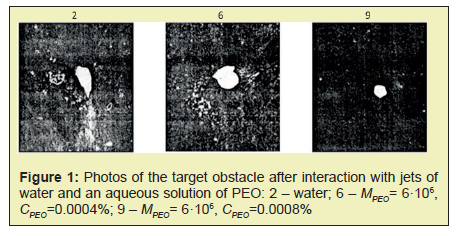
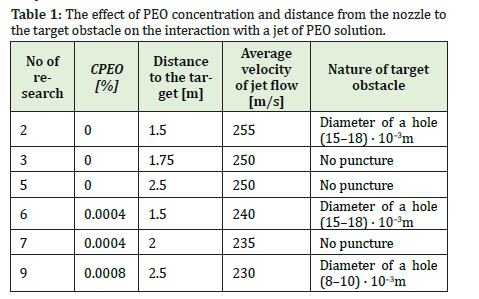
The experimental data are fully explained by a strong deformation effect of the hydrodynamic field on molecular bundles of the polymer. In a previous study),11 the transition of the bundle-expanded chain at a convergent flow (in the model conditions of the nozzle of the hydro perforator) of aqueous solutions of PEO was experimentally revealed. It is shown that the hydrodynamic field, which arises under conditions of convergent flow, leads to a significant degree of expansion of polymer molecules (60–70%) and to a bundle-to-chain transition.
The longitudinal velocity gradient, which occurs in the contraction cone nozzle of the hydrostand, can be calculated as not exceeding 2·103c–1. Therefore, despite the high speeds (250m/s) and resulting large shear velocity gradients, the conditions of deformation of polymer macromolecules in the conical nozzle of the water jet and in the inlet section of the model nozzle are almost the same. This indicates that during the flow of an aqueous polymer solution in the nozzle of the water jet, the PEO macromolecules are subjected to strong deformation of the longitudinal hydrodynamic field. All this supports the claim that the high-velocity water–polymer jet is “reinforced” by highly developed macromolecular chains of the polymer, and – considering the results from3 – then supramolecular structures. Part of the energy goes to the structural adjustment of the flow,2,11which lowers the average flow rate of the aqueous polymer solution and improves the quality of its formation, as a jet with small polymer additives is more compact (has a smaller diameter) than water see Figure 1 and Table 1. This contributes to an increase in the maximum distance from which the destruction of the steel barrier/target can occur.
The data of the experiments which are presented in Table 1 convincingly testify that the high destructive capacity of a high-velocity water jet with small polymer additives is not due to the Toms effect. This is confirmed, first of all, by the 8–10% reduction in the average jet velocity of the aqueous PEO solution relative to the water jet’s velocity at the same operating pressure and nozzle diameter. Thus, despite the lower flow rate of the polymer solution, its destructive capacity was much higher than that of the water jet.
The conclusion that the large destructive capacity of the high-velocity water jet with dissolved small polymer impurities was not due to the Toms effect also follows from the analysis of turbulent fluid flow presented below. In the case of near-wall turbulence, its structure should be affected by highly uncoiled macromolecular chains.19,20 To do this, there must be certain conditions in the turbulent flow, namely, the longitudinal velocity gradients and the time of deformation in them must be greater than 0.5/θc and θc, accordingly (where θc is the relaxation time of the polymer solution). At some fairly high dynamic velocities, when the formation and destruction of tensile zones occur at a high frequency, as follows from the work,21 increasing the strain rate should reduce the strain factor by de- creasing the time of the longitudinal velocity gradient. This is due to small-scale turbulence, the percentage of which increases sharply at high velocities.21,22 Also, the degradation of polymer solutions significantly reduces the Toms effect at high velocities.4 Therefore, in high-velocity turbulent flows, the hydrodynamic activity of PEO should decrease due to the discrepancy between the characteristic relaxation times of the aqueous PEO solution, the time scale of the flow (emissions) and the degradation of the PEO macromolecules.
To confirm the correctness of the above approach, it is necessary to conduct a detailed study of the polymer solution’s flow through the nozzles of a hydro perforator. At the same time, there are obvious advantages of using currents in the model of nozzles forming a stream in order to research the macromolecules’ interaction with a hydrodynamic field in connection with the possibility of studying experimentally the features of a polymer solution stream forming under controlled conditions.
From Equation (2) it follows that dissipation at a liquid stream can be characterised using effective viscosity. For a Newtonian fluid, it always coincides with the shear viscosity, whereas the effective viscosity of a non-Newtonian medium depends on the flow regimes and is an average characteristic. The latter is due to the fact that the viscosity of such a medium is different at points in space with different rates of deformation.23
The data that characterise the influence of outflow velocity through a nozzle on effective the viscosity of PEO aqueous solutions of various concentrations for molecular weight 6·106 are given in Figure 2.
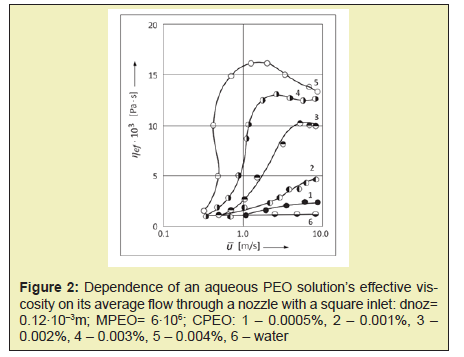
The error of viscosity measurement did not exceed 2%. It is seen that at relatively low velocities, the solutions be- have like Newtonian fluids and their viscosities are close to the viscosity of the solvent (water). At the critical thresholdvalue, u = ucr, the viscosity of the solution begins to increase; the sharper the increase, the higher the concentration of the polymer. The absence of growth of effective water viscosity with growth suggests that the specified effect is not connected with inertial turbulence. The data describing the influence of the diameter of the nozzle’s aperture on the effective viscosity of PEO solutions show Figure 3 that increasing the diameter of the nozzle essentially increases the critical speed.
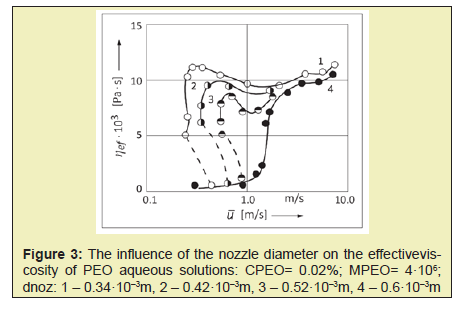
These experimental results Figure 3 allow us to assume that the observed changes of viscosity with growth u due to first of all at the expense of a difficult structure of the hydrodynamic field at the entrance section of the jet-forming nozzle (not at the expense of the macromolecules’ adsorption). Studies of solutions in a stationary Kuett field have shown that they can detect a decrease in viscosity only with increasing velocity gradient24 and only in turbulent motion do they show certain anomalies.25 Therefore, the change in the geometry in the inlet walls of the jet-forming nozzles (i.e. the conditions of solution deformation) should change the nature of the dependence of ηef on ![]() .
.
![]() These experimental results Figure 3 allow us to assume that the observed changes of viscosity with growth u due to first of all at the expense of a difficult structure of the hydrodynamic field at the entrance section of the jet-forming nozzle (not at the expense of the macromolecules’ adsorption). Studies of solutions in a stationary Kuett field have shown that they can detect a decrease in viscosity only with increasing velocity gradient24 and only in turbulent motion do they show certain anomalies.25 Therefore, the change in the geometry in the inlet walls of the jet-forming nozzles (i.e. the conditions of solution deformation) should change the nature of the dependence of ηef on
These experimental results Figure 3 allow us to assume that the observed changes of viscosity with growth u due to first of all at the expense of a difficult structure of the hydrodynamic field at the entrance section of the jet-forming nozzle (not at the expense of the macromolecules’ adsorption). Studies of solutions in a stationary Kuett field have shown that they can detect a decrease in viscosity only with increasing velocity gradient24 and only in turbulent motion do they show certain anomalies.25 Therefore, the change in the geometry in the inlet walls of the jet-forming nozzles (i.e. the conditions of solution deformation) should change the nature of the dependence of ηef on ![]() .
.
Figure 4 shows the curves that reflect the influence of conditions (inlet angle) of the polymer solution’s flow through the jet-forming nozzle with an inlet angle of 180° and 45° (smooth inlet and a standard factory nozzle) on the effective viscosity. It can be seen that the flow of the PEO solution in the first case (curve 1) is highly dissipative, while in the second (curve 2) it is slightly dissipative. At the same time, for a Newtonian liquid (water), the angle of entry into the nozzles does not play a significant role. A similar conclusion follows from the analysis of the data in Figure 5, which shows the results of experiments to identify the effect of the angle of entry into the nozzle and the PEO concentration on the effective viscosity of polymer solutions.
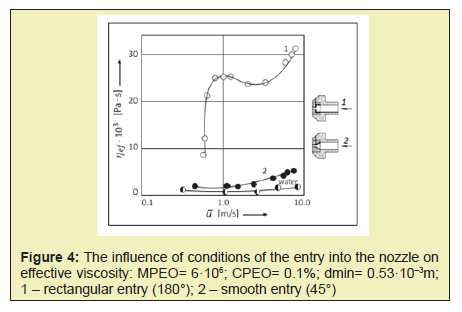
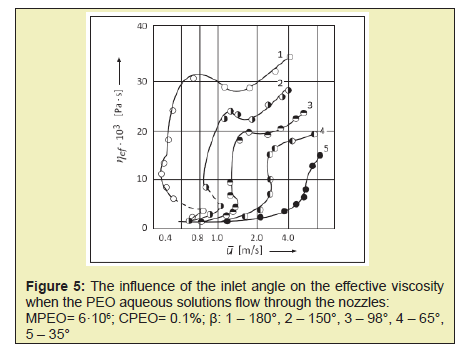
The experimental data characterise the peculiarities of the flow of PEO aqueous solutions through the model nozzles of a hydroperforator.
From the experiments regarding the detection of the influence of the entrance angle into a nozzle on the effective viscosity of PEO solutions, it is clear that there are phenomena that are typical for such flows, yet not for purely viscous environments. At some critical values of ukp, the effective viscosity begins to increase sharply, and the sharper this increase, the higher the concentration of polymer in solution and the wider the angle of entry into the nozzle. From the experiments regarding the detection of the influence of the entrance angle into a nozzle on the effective viscosity of PEO solutions, it is clear that there are phenomena that are typical for such flows, yet not for purely viscous environments. At some critical values of ukp, the effective viscosity begins to increase sharply, and the sharper this increase, the higher the concentration of polymer in solution and the wider the angle of entry into the nozzle. The highest value for ηef was observed for a nozzle with an inlet angle of 180°, i.e. when there was a sudden narrowing. Reducing the angle of entry into the hole of the nozzle leads to a decrease in ηef and displacement of the critical (threshold) speed in the direction of large values.
The ambiguity of the effective viscosity’s dependence on u̅(one velocity can correspond to two values of viscosity, see Figure 3 and Fiure 5 testifies to the difficult nature of these currents and, naturally, studying only integral characteristics of a flows draws attention not enough to understand the observed phenomena. As mentioned above, in a previous study11 the transition of the bundle-unfolded chain at a convergent flow (in the model conditions of the hydro perforator nozzle) of aqueous solutions of PEO was experimentally revealed. It has been established that the water–PEO system at convergent flow under certain regimes is self-regulating with negative feedback. It has been shown that increasing longitudinal velocity gradients leads to deformation of the macromolecular, which in turn causes a rearrangement of the flow structure and increase the time of influence of the longitudinal velocity gradient on the macromolecular chains. The hydrodynamic field, which occurs under conditions of convergent flow, leads to a significant proportion of the polymer molecules unfolding, hence the peculiarities of the convergent flow of even dilute solutions due to the ability of the macromolecules to easily change the shape of these molecular coils under the action of the complex structure of the hydrodynamic field that arises in the inlet nozzle of the hydro perforator and due to the increased molecular interactions at the molecular–supramolecular level caused by these changes. Therefore, experiments proving the possibility of supramolecular structure formation during the flow of an aqueous solution of PEO in a model of jet-forming nozzles of a hydro perforator are fundamental in terms of solving the destroying of nature, which causes the destructive power of a high-speed water–polymer jet. Below we turn to such experiments.
Experimental studies2,3 have demonstrated that self-organisation in space and time can be observed in aqueous solutions of PEO in the inlet section of the nozzle, which forms a jet (flow under tension). Therefore, to create a hydrodynamic field under tension, a convergent flow of water into a small hole in the plate (a model of a nozzle) with a diameter of 3·10–4m was used. Streams of PEO solution with a molecular weight of 6·106 were introduced into the water stream at a sufficient distance from the hole. The range of concentrations studied was 0.001–0.1%. The speed of the aqueous solution of PEO at the points of introduction of jets coincided with the speed of the main flow of water. Visualisation of the flow in the inlet area of the hole was carried out using admixtures of dye in the injected aqueous solutions.
At low flow rates, the coloured streams of PEO aqueous solution visualised the flow lines of the main stream Figure 6. The behaviour of the streams of PEO solutions was no different from the behaviour of streams of pure water injected into the convergent stream. When a critical water flow through the outlet of the nozzle was reached, the nature of the flow of jets of aqueous solution changed dramatically. Quite thick streams of PEO aqueous solution were transformed into thin threads, the length of which changed over time Figure 7.
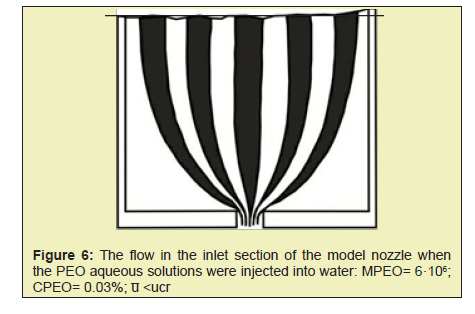
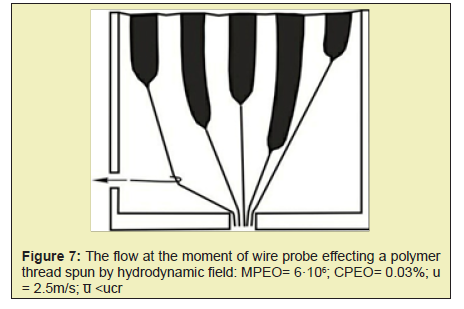
When observing the dynamics of the formation and destruction of individual threads (this is the oscillating nature of the movement of flooded streams of PEO solution) the following pattern is revealed. Initially, as the jets of PEO solution approached the hole, they were observed to bend smoothly towards the hole. At the same time, their velocity along these curvilinear trajectories began to increase more and more noticeably, as evidenced by the decrease in the thickness of the streams. Near the hole there was an abrupt decrease in the thickness of the streams of aqueous PEO solution, and they were transformed into a thin thread. The area of transformation of the thick stream into a thin thread began to move up the streams, which led to an increase in the length of the threads. Since the streams of the aqueous solution of PEO approached the hole at the same time, at each time the length of the threads spun by the flow from the individual streams of aqueous solution was different.
When a critical length was reached, the thread in the im- mediate vicinity of the hole broke. After that, the thread remaining at the top lost elasticity and sagged, i.e. one of the lines of the main flow of water. When the stream of aqueous PEO solution again approached the hole, everything repeated. The observed behaviour of flooded streams of aqueous PEO solution during tensile flow is due to the development of many PEO coils under the action of a hydrodynamic field. Rolling out molecular chains of PEO led to a decrease in their flexibility, which under certain conditions caused phase separation under the action of a hydrodynamic field, i.e. leading to the formation of a dynamic supramolecular structure.
The following experiment can confirm this formation of a dynamic supramolecular structure under the action of a tensile hydrodynamic field. In the subcritical modes of main water flow leakage in the inlet area of the hole, a thin wire-probe with a device for capturing the thread of an aqueous solution of PEO was introduced. The movement of this probe wire in a plane perpendicular to the jets did not change the flow pattern, as the jets of the aqueous PEO solution in these flow regimes are permeable to it. If the same experiment is repeated in the supercritical mode of water leakage, it is possible to capture one or more a polymer threads at the time of their growth and move aside, as shown in Figure 7. This is only possible in the presence of a sufficiently strong interaction between PEO molecules, i.e. in the emergence of a supramolecular structure, which is formed in this case under the action of a tensile hydrodynamic field. The minimum concentration of aqueous PEO solutions, when it was still possible to divert the aqueous solution of PEO, was 0.008%, which corresponds to the region of dilute solutions when the intrinsic viscosity [η]0 multiplied by the concentration of PEO CPEO was less than 1.24
These results and those given above suggest that aqueous solutions of PEO can be divided into at least three regions of concentration. This is the region of dilute aqueous PEO solutions, where PEO macromolecules under the action of a hydrodynamic field are subjected to strong deformation effects (expansion of macromolecules), but still weakly interact with each other in the expanded state. The second is the region of semi-dilute aqueous PEO solutions (intermediate), when in subcritical flow regimes the solutions are diluted, and in the supercritical ones – already concentrated in the result of the formation of supramolecular structures under the action of a hydrodynamic field. These dynamic structures should be considered the type of dynamic phase transitions dealt with by the theory of dissipative structures.26 The last region is the region of concentrated aqueous solutions of PEO ([η]0 · Copt > 1), when significant interactions between PEO molecules exist without the action of a hydro- dynamic field. It should be noted that the first two areas relate to the concentrations of the manifestation of great destructive power of a high-velocity jet of an aqueous solution of PEO. Thus, when aqueous solutions of PEO flow through the nozzles, forming a high-velocity jet, there may be a dynamic supra- molecular structure that is subject to Prigogine’s principles of self-organisation.26 These results are crucial for elucidating the nature of the great destructive capacity of a high-velocity water–polymer jet.
By elucidating the dynamics of macromolecules in the hydrodynamic field of a jet-forming nozzle and experimentally proving the formation of a dynamic supramolecular structure in the inlet section of the nozzle, we can obtain reasonable ideas to explain the mechanism behind the destructive capacity of a water–polymer jet.
Analysis of the concentration dependence of the destructive capacity of polymer solutions and the results indicating on formation of dynamic supramolecular structures in polymer solutions suggest that approaching the optimal concentration of polymer (C≥ Copt), the destructive capacity of water generates anisotropic supramolecular formations that have a lifetime 10 times longer than the relaxation time of the macromolecule.11 A further increase in the PEO con- centration led to the creation of conditions for the interaction between individual molecules of PEO, even without the action of a hydrodynamic field. This leads to a sharp increase in the usual viscosity and, of course, to a relatively strong decrease in the flow rate of the aqueous solution. The consequence of this is a decrease in the destructive capacity of the water–polymer jet when reaching a relatively high concentration of PEO in aqueous solution.
To substantiate and systematise the physical laws of the fracture mechanism in the process of perforating the casing strings of oil and gas wells with a stream of polymer solution and the relationship of the individual phenomena that occur, it is important to develop schemes for calculating basic technological parameters and rational modes of a hydro perforator. The experimental data show that the process of water–polymer perforation of oil and gas well casing strings is complex and has specific features which contrast with the perforation of the water jet and hydro-abrasive jet.
The subject of the work – to develop a highly efficient innovative method for perforating oil and gas well casing strings – can be achieved through a method of hydrostream perforation of the well that includes directing the jet to the place of perforation, sealing the inner cavity of the tubing and jet apparatus, actuating the ball valve located at the bottom of the jet apparatus, sealing the annulus with a self-sealing gland, and supplying the tubing pipe with cutting fluid, that is, an aqueous solution of PEO with a molecular weight of M = 6·106 at a concentration of CPEO= 0.003–0.007% by weight and with an operating pressure of 100–300MPa.
Perforation works were performed in the laboratory using a hydraulic stand based on a URG-3020 installation. The model of the obstacle (target) on which the perforation efficiency was tested is described in the experimental part. The results of the destruction of the model barrier by a water–polymer jet with PEO concentrations of 0.0025–0.008% and a PEO molecular weight of 6·106, a leakage pressure of 200MPa, a nozzle diameter of 3·10-3m and a perforation time of 10min are provided in Table 2.
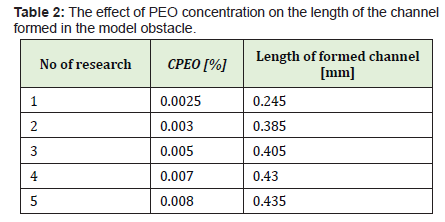
The tests were also performed with a concentration of PEO aqueous solution of 0.005%, but the pressure of the destructive fluid changed. These results are presented in Table 3.
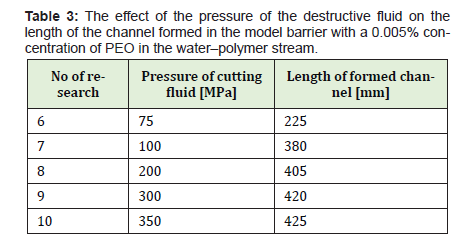
Decreasing the pressure below 100MPa reduced the perforation efficiency, while raising it above 300MPa caused a slight increase in the length of the channel; however, in a production environment there are technical difficulties in maintaining such high pressures. Comparative perforation works were performed on a similar model of the obstacle using HSP (sand fractional composition: 0.5–1.2mm; concentration: 30–50kg/m3; leak- age pressure: 200MPa). In the case of HSP, the length of the channel in the obstacle model was 320mm.
The results presented in Tables 2 and 3 show that PEO additives in the selected range of concentration and flow regimes will lead to greater channel formation efficiency during the perforation of oil and gas well casings, which will allow more efficient use of oil and gas fields’ potential.27
Experimental and field testing of the proposed method of perforating the casing columns of oil and gas well casing strings– using a jet of PEO aqueous solution – which was carried out during the secondary opening of the productive reservoir at a well in the Carpathian oil-and gas-bearing region, confirmed the practical and economic feasibility of its use. The environmental friendliness of PEO additives should be noted, because this polymer is not harmful to humans and does not harm nature.
- 1. The mechanism behind the destructive power of a high-velocity jet of polymer solution has been discovered. It is in the destructive action of the dynamic pressure of the water–polymer jet, “reinforced” by highly developed macromolecular chains and dynamic anisotropic supramolecular structures formed under the action of expanding flow in the inlet section of the hydro perforator nozzle that forms the high-velocity jet flow.
- 2. Research and field testing of the method of hydro jet perforation of well casings that uses aqueous solutions of PEO confirmed that the process of well perforation is more efficient, environmentally friendly and resource-saving than hydro-sandblasting perforation.
- 3. The new data on the influence that different jet-forming nozzles have on the hydrodynamic behaviour of aqueous polymer solutions during their flow through the nozzles and the established patterns of the influence that the structures have on the efficiency of well perforation – aimed at developing a highly efficient process for perforating oil and gas well casing strings with a high-velocity stream of polymer solution – are innovative, relevant and promising.
None.
None.
Authors declare that there is no conflict of interest.
- 1. Pogrebnyak VG, Chudyk II, Perkun IV. Solutions of Polymers in the Oil and Gas Technologies. Multi-authored monograph. Prospects for developing resource-saving tehnologies in mineral mining and processing. Petrosani. Romania: UNIVERSITAS Publishing. 2022:110–294.
- 2. Ivanyuta YuF, Naumchuk NV, Pogrebnyak VG, et al. Flow structure of aqueous solutions of polyethylene oxide in the inlet region of short capillaries. Journal of Engineering Physics. 1985;49(4):1192–1197.
- 3. Pogrebnyak VG, Naumchuk NV. Dynamic structurization in solutions of hydrodynamically active polymers. Journal of Engineering Physics and Thermophysics. 1992;63(2):763–765.
- 4. Pogrebnyak AV, Perkun IV, Pogrebnyak VG. Degradation of polymer solutions in a hydrodynamic field with a longitudinal velocity gradient. Journal of Engineering Physics and Thermophysics. 2017;90(5):1219–1224.
- 5. Diment ON, Kazanskii KS, Miroshnikov АМ. Glikoli i drugiye proizvodnye okiseyetilena i propilena. Monografiya. Moskva. Khimiya. 1976:p.374.
- 6. Salyanov VI. Relation between molekular-strukture of aqueous-solutions of polyethy- lene-glycol and comhaction of double-standed DNK-molecules. Molekulyarnaya Biologiya. 1978;12(3):485–495.
- 7. Keller А, Odell JA. The extensibility of macromolecules in solutions, a new focus for macromolecular science. Colloid Polym Sci. 1985;263(3):181–201.
- 8. Brestkin YuV. Dynamic coil–extended chain phase transition in the longitudinal field. Acta Polymerica. 1987;38(8):470–477.
- 9. Brestkin YuV. Bire-fringence effects of polymer-solutions in hydrodynamic fields. Vysokomolekulyarnye Soedineniya Seriya B. 1989;31(11): 844–846.
- 10. Pogrebnyak AV, Perkun IV, Pogrebnyak V G, et al.Thermal Effects in the Flow of a Polymer Aqueous Solution Through a Hydrocutting Jet-Forming Head. Journal of Engineering Physics and Thermophysics. 2021;94(1):137–142.
- 11. Pogrebnyak A, Chudyk I, Pogrebnyak V. et al. Coil-uncoiled chain transition of polyethylene oxide solutions under convergent flow. Chemistry and Chemical Technology. 2019;13(4):465–470.
- 12. Povkh IL. Relation between molecular structure of polyethyleneoxide and drag reduction. Journal of Engineering Physics. 1979;37(4):1131–1136.
- 13. Pogrebnyak VG, Naumchik NV. On the hydrodynamic acti- vity of polymers in high-velocity flowsю. Inzhenerno Fizicheskii Zhurnal. 1995;68(1):146–148.
- 14. Kuzmin RA, Tihomirov RA, Kravchenko DV. O preimush- chestvakh gidrorezaniya materialov struey zhidkosti s dobavkami vodorastvorimykh polimerov. Aerokosmicheskie tekhnologii i obrazovanie narubezhe vekov. Materialy Vserossiyskoy Nauchno-Tekhnicheskoy Konferenczii. Rybinsk. Rossia: RGATA. 2002;2:53–54.
- 14. Atanov HA, Gidroimpulsnye ustanovki dliya razrusheniiy gornykh porod. Monografiya. Kiev. Vyshcha shkola. 1987; p.152.
- 16. Brenner VA, Jabin AB, Pushkarev AE, et al. Gidrostrujny`e tekhnologii v promyshlennosti. Gidromekhanicheskoe razrushenie gornykh porod. Monografiya. Moskva. Akad. Gornykh Nauk. 2000; p.343.
- 17. Azzam P, Rjanova АВ, Svitasheva KK. Ellipsometriya i po- lyarizovannyjsvet. Monografiya, Moskva. Mir. 1981:p.583.
- 18. Kudin AM. On the sizes of associates in solutions of polymers that reduce the hydrodynamic resistance. Hydromekhanika. Kiev. Science Dumka. 1972;20:82–87.
- 19. Pogrebnyak VG, Ivanyuta Yu F, Naumchuk IV. Unrolling of macromolecules under wall turbulence conditions. Inzhenerno Fizicheskii Zhurnal. 1991;61(6):925–927.
- 20. Kryvenko GM, Pogrebnyak AV, Perkun IV. The nature of Hydrodynamic Drag Reduction of Oil Flow in Pipelines by Polymer Additions. Petroleum Science and Engineering. 2017;2(3):79–85.
- 21. Cantwell BI. Organized motion in turbulent flow. Ann Rev Fluid Mech. 1981;13:457–519.
- 22. Bredshou P, Vvedenie v turbulentnost i eeizmerenie. Monografiya. Moskva. Mir. 1974:p.278.
- 23. Pogrebnyak VG, Pogrebnyak AV, Perkun IV. Maxwell fluid flow in system supplying hydrodynamically active polymer to boundary layer of streamlined object. Mathematical Modeling and Computing. 2021;8(1):58–68.
- 24. Frenkel SYa, El’iashevich H K, Panov YuN. Kontsentri- rovannye rastvory polimerov. Uspekhi khimii i fiziki polimerov. Moskva Khimiya. 1970:87–138.
- 25. Pilipenko VN. Vliyanie dobavok na pristennye turbulentnye techeniya. Itogi Nauki i Tekhniki. Ser. Mekhanika Zhidkosti i Gaza. Moskva. VINITI. 1980;15:156–257.
- 26. Hlesdorf P, Prigojin I. Termodinamicheskaya teoriya struktury, ustoychivosti i fluktuatsii. Monografiya. URSS. 2003: 280.
- 27. Pogrebnyak VG, Perkun IV, Pogrebnyak AV, et al. The method of hydrojet perforation of wells. Pat. No.150245, Ukraine. IPC (2022.01) Е21В43/00 Е21В 43/14 (2006.01). 2022;p.3.

